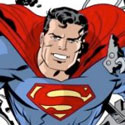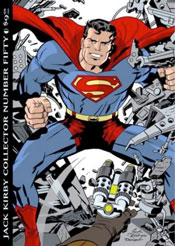
Kirby Five-Oh: Celebrating Fifty Years of the King of Comics
Collected Jack Kirby Collector vol. 6
edited by John Morrow
Twomorrws

Let’s face it, “lists” issues are by and large worthless. They’re annoying, both qualitatively and quantitatively frustrating, the equivalent of light chitchat rather than thoughtful discourse, and ever more prevalent in even fine music publications as MOJO (fear not, Ink 19 has a relative absence of such lists). HOW-fucking-EVER, I will make an exception when such a book of lists is dedicated to comics legend Jack “King” Kirby. Mainstay of Marvel Comics, creator of Captain America (Andrew Coulon rightly pegged Kirby’s Captain America #1 cover of Cap taking Hitler to fist city as one of comics’ most enduring images), Fantastic Four, Thor, the X-Men and the Hulk, and then after jumping to DC Comics, mastermind of the multi-title Fourth World saga (Mr. Miracle, New Gods, Forever People) as well as OMAC and Kamandi. Kirby was an artist and writer just as at home writing superhero hero titles as he was war, romance, horror, science fiction and western titles. A man whose life story was adapted into Michael Chabon’s Kavalier and Klay and without whom most of the popular comics mainstream titles you read today would simply not exist. A tireless graphic innovator and storyteller, pure and simple. I was more than familiar with Kirby’s work going in, but I didn’t know how much of an idea generator, concept machine, and tireless worker the guy was. He was like an omnivore in reverse, or in the foreword writer’s words, a true savant.
Kirby Five-Oh is a true labor of love for superfan Twomorrows publisher (and Kirby Collector zine compiler) John Morrow. Indeed, putting out Kirby Collector was the impetus for the whole Twomorrows imprint. Herein Morrow has pulled out all of the stops with a lovely tabloid-size layout, bursting with original art, finished layouts and feverish character sketches that give valuable glimpses inside a restless mind with a limitless imagination. It’s a beautiful, oversize book, and let’s face it, bigger is indeed better when presenting Kirby’s intricate and kinetic artwork. Perfect for the coffeetable – Kirby fingers, Kirby crackle, fantastical landscapes, cinematic angles, lithe figures and incredible costumes leap off every page.
As intimated earlier, the book is divided into several Kirby-themed Top 50 lists, with the finalists all chosen by a broad range of Kirby enthusiasts, both famous (John Romitas Sr and Jr, fr’instance) and fans. These are: 50 Best Kirby Stories, 50 Best Kirby Covers, 50 Best Examples of Unused Kirby Art (and apparently pages are still being discovered and published from the man’s voluminous archives), 50 Best Kirby Character Designs, and 50 People Influenced by Jack Kirby (testimonials/interviews, basically). And don’t worry, none of this is retread material from Kirby Collector, Five-Oh is all new content, much of it released from the personal collection of the Kirby family and private collectors.
Though none of the articles are really groundbreaking journalism, I can see how several of these lists could inspire all sorts of spirited discussion amongst Kirby fans. It you’d like, I can give you a starting point: How is it that the Top Character Designs section doesn’t include the Wingless Wizard, MODOK, or Baron Vundabarr? See, it’s fun. And all sorts of comics creators, both peers and spiritual heirs, join in. Many a fulsome tribute is offered. An interview with Grant Morrison, last seen writing Final Crisis for DC which delves deep into the Fourth World mythology, is especially enlightening and it’s really cool to read praise offered by European scholars and comics writers.
In the middle, there’s a glossy picture section that really humanizes – the shots with the pipe and the sweater, what a fucking dude. Seeing picture after picture of Kirby clutching a pipe, I suddenly figure out why every Kirby protagonist, Reed Richards, Bruce Banner, Don Blake, every fourth guy in a crowd scene, had pipe in hand. (He makes it look cool.) Sectons touching on his work in collage are great – his stuff was almost avant-garde. Fascinating that a guy with one of the highest page-rates in comics had time enough to painstakingly construct these assemblages. Sorta reminds me of how Guided By Voices’ Bob Pollard, another guy who’s no slouch in the workrate department, found moments of peace and satisfaction from assembling collages at his kitchen table.
Hot on the heels of this anniversary tome came the sixth volume of collected issues of the Kirby Collector, compiling issues 23-26. And though you’d think that a zine devoted to just one guy would have trouble hustling up enough material and artwork for the usually overstuffed issues, it’s not the case at all. Kirby created cornerstones for both Marvel and DC comics to base their hero lines on, and that’s not even counting his later work for Topps and Pacific and in animation, not to mention his prodigious output during the Golden Age and his forays in Romance, Western, Gangster and Monster comics for myriad publishers in the 1950s. The Kirby Collector is devoted to all of these eras, and with enthusiastic contributors and the full cooperation of the Kirby family (which means access to his seemingly endless artchive of unused artwork), not only is this the final word in Kirby scholarship but it’s an enterprise that can keep going for quite some time without repeating itself.
Of the issues collected here, three of the four are devoted to a particular theme in Kriby’s work – number 24 centers around Kirby’s greatest battles, 25 is the war issue (WW2 etc) and 26 is the Gods issue, dealing with the issue of divinity in his art and writings. Some of the articles are good stuff, solid scholarly work that wouldn’t be out of place in the Journal of Popular Culture, and there are some interesting threads explored, like Kirby’s contradictory signals on religion (was Silver Surfer meant to be a Jesus analogue?), how much his experiences in the war made their way into his comics, or the unpublished African American-themed Soul Love romance comic. The problem with a magazine like this is that many of the articles are just testimonials or love letters to his work (don’t get me wrong, he deserves love fests more than most, they’re just hard going at times). As far as text content, I got the most out of the interviews – with Kirby with his granddaughter, with John Severin, Walt Simonson. Good stuff. But really, what are the words in the Kirby Collector but a textual frame for the artwork, and my god, there is page after page of boffo artwork. Pencilled pages sit next to finished pages, fighting for space with panomaric splashes, unpublished stories, fantastical machine schematics, convention sketches, concept art, face studies, Darkseid galore. It’s all here.
There’s so much affection, so much love poured into every page – you might be forgiven for picturing a tear trickling down into even the granite cheek of Kirby’s most evil creation, Darkseid. But it’s only befitting a King.
Twomorrows: http://www.twomorrows.com












